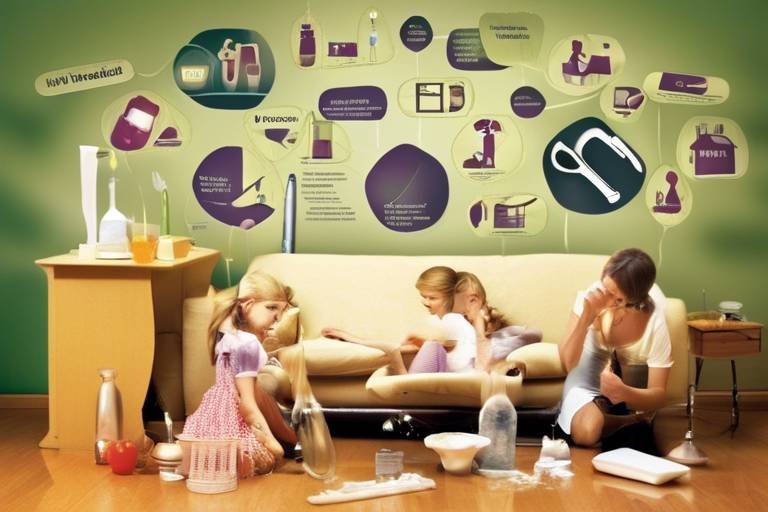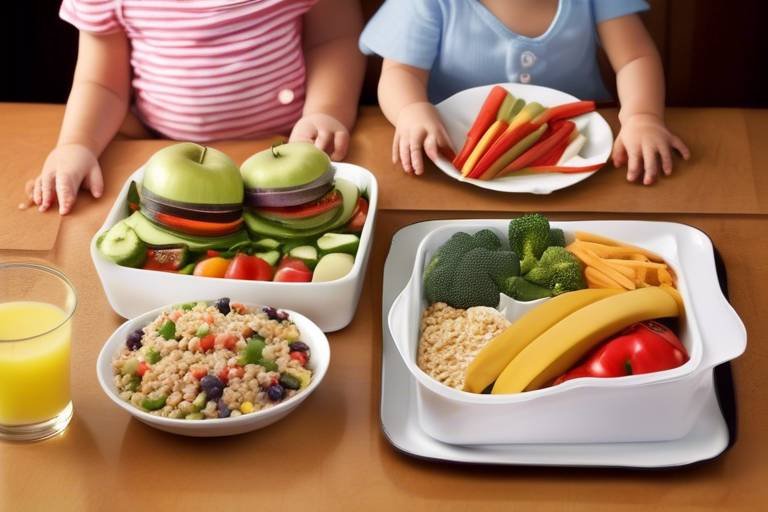Common Household Hazards Affecting Family Health
Every day, we create a cozy haven in our homes, a place where we feel safe and comfortable. However, lurking beneath the surface are various household hazards that can silently threaten our family’s health. From the air we breathe to the products we use, it’s essential to recognize these potential dangers. Think of your home as a fortress; while it provides shelter, it can also hide vulnerabilities that could lead to health issues. This article dives deep into the common hazards found in households, offering insights and practical tips to safeguard your loved ones.
Did you know that indoor air can be more polluted than outdoor air? Shocking, right? Poor indoor air quality can lead to a myriad of health problems, including respiratory issues and allergic reactions. Common sources of indoor air contaminants include tobacco smoke, mold, pet dander, and volatile organic compounds (VOCs) emitted from paints and cleaning products. To improve air quality in your home, consider the following:
- Ventilate regularly by opening windows and using exhaust fans.
- Invest in an air purifier with a HEPA filter.
- Keep humidity levels between 30-50% to prevent mold growth.
- Use natural cleaning products whenever possible.
By taking these simple steps, you can create a healthier breathing environment for your family.
Many people don’t realize that the cleaning products they use daily can contain harmful chemicals. These substances can pose serious health risks, particularly to children and pets who may be more sensitive to toxins. Ingredients like ammonia, bleach, and phthalates can lead to respiratory problems and skin irritations. Instead of reaching for those conventional cleaners, why not consider safer alternatives? For instance, vinegar and baking soda can work wonders for cleaning without the toxic side effects.
When it comes to keeping pests at bay, many families turn to pesticides and insecticides. However, these products can be particularly dangerous, especially for young children and pets who may come into contact with treated surfaces. The dangers of these chemicals are not just theoretical; they can lead to serious health issues, including neurological disorders. To protect your family, consider eco-friendly pest management solutions such as:
- Using essential oils like peppermint or tea tree oil as natural repellents.
- Keeping your home clean and free of food debris that attracts pests.
- Employing traps and barriers instead of chemical sprays.
Proper storage of household chemicals is crucial for safety. Always keep cleaning products and pesticides out of reach of children and pets. Store them in locked cabinets or high shelves. Additionally, ensure that all containers are tightly sealed to prevent spills and leaks.
Knowing how to read product labels can help you identify harmful ingredients. Look for key terms like "toxic," "corrosive," and "flammable." Familiarize yourself with symbols that indicate danger, such as skulls and crossbones or exclamation marks. By being a savvy shopper, you can make informed decisions that prioritize your family's health.
Beyond chemicals, physical hazards in the home can lead to injuries. Common dangers include slippery floors, sharp objects, and cluttered spaces that can cause falls. It’s crucial to recognize these risks and take proactive measures. For example, securing rugs with non-slip mats can prevent accidents, and keeping pathways clear can help everyone navigate safely. Remember, a little prevention goes a long way in avoiding unnecessary trips to the emergency room!
Foodborne illnesses are a significant concern for family health. Contaminated food can lead to severe health issues, especially for children and the elderly. To minimize the risk, it's essential to follow best practices for food storage, preparation, and hygiene. This means washing hands thoroughly before handling food, cooking meats to the appropriate temperatures, and keeping raw and cooked foods separate.
Understanding how to store food correctly can minimize the risk of spoilage and illness. Always check expiration dates and store perishables in the refrigerator. Use airtight containers to keep food fresh and prevent contamination. Remember, when in doubt, throw it out!
Safe cooking practices are vital to preventing kitchen accidents. Common cooking hazards include hot surfaces, sharp knives, and flammable materials. Always use oven mitts when handling hot pots and pans, and keep knives sharp to reduce the risk of slips. A well-organized kitchen can significantly reduce the chances of accidents, so keep your cooking space tidy and free of clutter.
Q: What are some signs of poor indoor air quality?
A: Signs include persistent odors, increased allergy symptoms, and visible mold growth.
Q: How can I safely dispose of household chemicals?
A: Check with your local waste management for hazardous waste disposal programs.
Q: What are natural alternatives to common household cleaners?
A: Vinegar, baking soda, and lemon juice are effective and non-toxic cleaning agents.
Q: How can I prevent foodborne illnesses at home?
A: Practice good hygiene, cook foods to safe temperatures, and store food properly.

Indoor Air Quality
Indoor air quality is often an overlooked aspect of our homes, yet it plays a crucial role in the overall health and well-being of our families. Imagine breathing in air that’s filled with invisible pollutants—it's a bit like swimming in a pool of toxins without even realizing it! Common sources of indoor air pollution include volatile organic compounds (VOCs) from paints, cleaning products, and even furniture, as well as allergens like dust mites, mold, and pet dander. These contaminants can lead to a range of health issues, from headaches and fatigue to respiratory problems and allergies.
So, how can we improve the air quality in our homes? It's simpler than you might think! Here are some effective strategies to create a healthier indoor environment:
- Ventilation: Ensure proper ventilation by opening windows and using exhaust fans in kitchens and bathrooms. Fresh air circulation can significantly reduce indoor pollutants.
- Houseplants: Certain indoor plants, like spider plants and peace lilies, can help purify the air by absorbing toxins and releasing oxygen.
- Regular Cleaning: Frequent vacuuming and dusting can help minimize dust and allergens. Consider using a vacuum with a HEPA filter for the best results.
- Air Purifiers: Investing in a quality air purifier can also be beneficial, especially for those with allergies or asthma.
Moreover, it's essential to be mindful of the products we bring into our homes. Opting for low-VOC paints and cleaning supplies can make a significant difference. Also, regularly checking for and addressing any signs of mold or dampness can prevent potential health hazards. The key is to create a living space that not only looks good but also feels good to breathe in!
In summary, maintaining good indoor air quality is a vital step in safeguarding your family’s health. By being proactive and making small changes, you can ensure that the air in your home is fresh, clean, and safe for everyone.

Household Chemicals
Many of us take for granted the cleaning products we use daily, but the truth is that many household chemicals can be quite harmful. From the air we breathe to the surfaces we touch, these chemicals can silently impact our health and well-being. It's essential to recognize that while these products help us maintain a clean home, they can also introduce a range of toxic substances into our environment. For instance, common cleaning agents often contain ingredients that can lead to respiratory issues, skin irritations, and other health concerns, especially for children and pets who are more vulnerable.
One of the most concerning aspects of household chemicals is that they are often used without full knowledge of their potential risks. Many products are laden with ingredients that can be harmful if inhaled or absorbed through the skin. For example, products like bleach, ammonia, and certain air fresheners can emit volatile organic compounds (VOCs) that compromise indoor air quality. These VOCs can lead to headaches, dizziness, and long-term respiratory problems. It's vital to consider safer alternatives that are just as effective without the toxic side effects.
Fortunately, there are numerous safer alternatives available that can help maintain a clean home without compromising health. Here are some eco-friendly substitutes that you can easily make or purchase:
- Baking soda: A versatile cleaning agent that can be used for scrubbing surfaces, deodorizing, and even unclogging drains.
- White vinegar: An excellent natural disinfectant that can cut through grease and remove odors.
- Castile soap: A plant-based soap that is effective for cleaning dishes, surfaces, and even laundry.
By opting for these natural alternatives, you can significantly reduce the number of harmful chemicals in your home. Additionally, it's crucial to educate yourself about the products you choose. Always read the labels and be aware of the ingredients listed. Look for products that are marked as non-toxic, biodegradable, or free from harmful chemicals.
Moreover, understanding the importance of proper storage of household chemicals cannot be overstated. Many accidents involving children and pets occur because hazardous substances are left within reach. It's essential to store these products in a secure place, preferably in a locked cabinet, and to keep them in their original containers. This practice not only prevents accidental ingestion but also helps in identifying the contents quickly in case of emergency.
In the quest for a safer home, being informed about the chemicals we use is key. By choosing safer cleaning products and implementing effective storage practices, we can create a healthier environment for our families. The journey towards a toxin-free home starts with awareness and proactive choices.
Q: What are some signs that a household chemical might be harmful?
A: Signs include strong odors, skin irritation, respiratory issues, and any product warnings on the label indicating toxicity.
Q: Are natural cleaning products as effective as chemical ones?
A: Yes, many natural cleaning products can be just as effective when used correctly and can also be safer for your health.
Q: How can I find out more about the chemicals in my cleaning products?
A: You can check the product label for ingredients and look for resources online that provide information about household chemicals and their effects.

Pesticides and Insecticides
Pesticides and insecticides are common household products that many families use to keep their homes free of pests. While these substances can be effective in managing unwanted insects and rodents, they also come with a host of potential health risks, particularly for vulnerable groups like children and pets. The truth is, the very chemicals designed to protect your home can sometimes pose a greater danger than the pests themselves. So, what should you know about these products to keep your family safe?
Many pesticides contain toxic ingredients that can lead to serious health issues if not handled properly. For instance, exposure to these chemicals can result in symptoms ranging from headaches and dizziness to more severe reactions like respiratory issues or even long-term neurological damage. It's alarming to think that the very products we use to ensure a clean and pest-free environment could be harming our loved ones. This is especially concerning in homes with young children, who are more susceptible to the effects of toxic substances due to their smaller body size and developing systems.
Moreover, pets are equally at risk. They often come into contact with treated surfaces or ingest residues left behind after application. This can lead to symptoms such as vomiting, lethargy, or worse. As responsible pet owners, it's essential to consider the implications of using chemical pesticides around our furry friends. So, what can you do to mitigate these risks?
Fortunately, there are eco-friendly pest management solutions available that can help you keep your home pest-free without compromising your family's health. For instance, consider using natural alternatives like diatomaceous earth or neem oil. These options are not only effective but also significantly less harmful. Additionally, employing preventive measures such as sealing cracks, maintaining cleanliness, and using traps can significantly reduce the need for chemical interventions.
To further emphasize the importance of safety, here’s a quick comparison of common pesticides versus natural alternatives:
| Type | Common Pesticides | Natural Alternatives |
|---|---|---|
| Insecticides | Pyrethroids (e.g., permethrin) | Diatomaceous Earth |
| Rodenticides | Anticoagulants (e.g., bromadiolone) | Essential Oils (e.g., peppermint) |
| Fungicides | Chlorothalonil | Neem Oil |
As you can see, there are effective and safer alternatives to traditional pesticides that can help you manage pests without jeopardizing your family's health. Always remember to read labels carefully and choose products that are less harmful. By making informed choices, you can create a healthier living environment for everyone.
In conclusion, while pesticides and insecticides can serve a purpose in maintaining a pest-free home, it is crucial to be aware of their potential health risks. By opting for safer alternatives and employing preventive strategies, you can protect your family and pets from unnecessary exposure to harmful chemicals. After all, a clean home should not come at the expense of your loved ones' health!
- What are the signs of pesticide exposure in children? Symptoms can include headaches, nausea, dizziness, and respiratory issues. If you notice these symptoms after pesticide application, consult a doctor immediately.
- Are natural pest control methods effective? Yes! Many natural alternatives can be just as effective as chemical pesticides when used correctly.
- How can I safely dispose of old pesticides? Always follow local guidelines for disposal. Many communities have hazardous waste days where you can safely dispose of these products.

Safe Storage Practices
When it comes to keeping your family safe from household hazards, proper storage of chemicals is paramount. Imagine your home as a fortress; every room should be fortified against potential dangers. Household chemicals, whether they are cleaning products, pesticides, or other hazardous materials, can pose serious risks if not stored correctly. Start by ensuring that these substances are kept out of reach of children and pets. A good rule of thumb is to store them in high cabinets or locked storage areas. This simple act can prevent a world of trouble.
Another critical aspect of safe storage is to keep these chemicals in their original containers. Why? Because the labels contain essential information, including safety warnings and instructions for use. If you transfer a chemical to a different container, you might forget what it is, leading to accidental misuse. Furthermore, always ensure that the containers are tightly sealed to avoid leaks and spills. You wouldn't want a toxic spill in your kitchen or bathroom, would you?
Temperature also plays a significant role in the effectiveness and safety of stored chemicals. Many products should be kept in a cool, dry place away from direct sunlight. For example, some cleaning agents can become unstable if exposed to heat, potentially causing dangerous reactions. If you're unsure about the ideal storage conditions for a specific product, consult the label or the manufacturer's website for guidance.
Lastly, consider organizing your storage space. Create a dedicated area for hazardous materials and label everything clearly. This not only helps you find what you need quickly but also serves as a visual reminder of what’s stored there. You can use a simple table to keep track of your household chemicals, including their names, storage locations, and expiration dates:
| Chemical Name | Storage Location | Expiration Date |
|---|---|---|
| All-Purpose Cleaner | Under the sink | 12/2024 |
| Insecticide Spray | Locked cabinet | 03/2025 |
| Bleach | Utility closet | 06/2023 |
By following these safe storage practices, you can significantly reduce the risk of accidents and keep your family safe. Remember, a little caution goes a long way in creating a secure home environment.
- What should I do if a chemical spills?
Immediately evacuate the area and follow the cleaning instructions on the label. If necessary, call poison control. - How can I dispose of old chemicals safely?
Check with your local waste management facility for hazardous waste disposal days or guidelines. - Are there any household products I should avoid?
Yes, avoid products with harsh chemicals like ammonia or chlorine if you have children or pets. - Can I store chemicals in the garage?
Only if the garage is temperature-controlled and away from direct sunlight; otherwise, it's best to store them indoors.

Understanding Labels
When it comes to keeping your home safe, understanding the labels on household products is like having a secret decoder ring. Those seemingly cryptic symbols and terms can provide crucial information about the safety and potential hazards of the products you use every day. But what exactly should you be looking for? Let's break it down.
First off, you’ll often find hazard symbols on labels that indicate the level of risk associated with the product. For instance, a skull and crossbones usually means the substance is toxic, while a flame symbol indicates flammability. These visual cues are your first line of defense against potential dangers lurking under your sink or in your pantry.
Next, pay attention to the ingredients list. It’s essential to know what you’re bringing into your home. Some common harmful ingredients to watch for include:
- Phthalates: Often found in fragrances, these can disrupt hormonal balance.
- Formaldehyde: A known irritant and potential carcinogen, often present in cleaning products.
- Ammonia: While effective for cleaning, it can be harsh on respiratory systems.
Another critical aspect is the signal words found on the label, such as "Caution," "Warning," or "Danger." These words indicate the level of toxicity:
| Signal Word | Meaning |
|---|---|
| Caution | Low toxicity; may cause mild irritation. |
| Warning | Moderate toxicity; can cause serious injury or illness. |
| Danger | High toxicity; can be fatal if ingested or improperly handled. |
Moreover, don’t overlook the precautionary statements that follow these signal words. They provide specific instructions on how to safely use, store, and dispose of the product. Ignoring these can lead to accidents that could have easily been prevented. For example, a product labeled with “Keep out of reach of children” is a clear warning that it contains hazardous substances.
Lastly, familiarizing yourself with the Consumer Product Safety Commission (CPSC) guidelines can empower you to make informed choices. They provide resources and tips for understanding product labels and the potential risks associated with household items. Remember, knowledge is your best ally in creating a safe home environment.
In summary, understanding product labels is not just about reading; it’s about interpreting the information they convey. By being vigilant and informed, you can significantly reduce the risks associated with household chemicals and protect your family’s health.
1. Why is it important to read product labels?
Reading product labels helps you identify harmful ingredients and understand the risks associated with household products, ensuring a safer environment for your family.
2. What should I do if I find a product with a hazardous label?
If you encounter a product with a hazardous label, consider disposing of it safely and looking for a safer alternative that does not contain harmful chemicals.
3. Are there any resources for understanding product labels better?
Yes! The Consumer Product Safety Commission (CPSC) offers guidelines and information on interpreting product labels and understanding potential risks.

Physical Hazards
Physical hazards in the home are often overlooked, yet they can lead to serious injuries, especially for children and the elderly. Have you ever tripped over a toy or slipped on a wet floor? These seemingly minor incidents can result in significant accidents. It's crucial to recognize that the environment we create at home plays a vital role in our family's safety. From sharp objects to uneven surfaces, the hazards that lurk around our living spaces can be more dangerous than we realize.
One of the most common physical hazards is the risk of falls. According to the Centers for Disease Control and Prevention (CDC), falls are the leading cause of injury among older adults. Imagine your grandparent living alone, navigating a home filled with clutter and slippery floors. It's a recipe for disaster! To mitigate these risks, consider implementing some simple changes:
- Keep floors clear of clutter and remove any tripping hazards.
- Use non-slip mats in bathrooms and kitchens to prevent slips.
- Install grab bars in the bathroom to assist with stability.
Another area to watch out for is the presence of sharp objects. Knives, scissors, and tools can be hazardous, especially if left within reach of curious little hands. It's essential to store these items safely. For instance, a locked drawer or a high shelf can keep them out of reach of children. Additionally, teaching your kids about the dangers of sharp objects can empower them to be more cautious around them.
Moreover, don’t forget about electrical hazards. Frayed cords, overloaded outlets, and water near electrical devices can create dangerous situations. Regularly inspect your cords and outlets, and make sure to keep them away from water sources. If you notice any damage, replace them immediately. The last thing you want is an electrical shock or fire in your home!
Creating a safer living environment requires vigilance and proactive measures. By identifying potential hazards and addressing them, you can significantly reduce the risk of accidents. Remember, safety is not just about removing hazards; it’s also about educating your family on how to navigate their home safely. This way, everyone can enjoy their space without fear of injury.
Q: What are some common physical hazards in the home?
A: Common physical hazards include tripping hazards like clutter and loose rugs, sharp objects such as knives and scissors, and electrical hazards like frayed cords.
Q: How can I prevent falls in my home?
A: To prevent falls, keep floors clear of clutter, use non-slip mats, and install grab bars in bathrooms.
Q: What should I do if I notice a hazard in my home?
A: If you notice a hazard, address it immediately by removing the danger or repairing it. Regularly inspect your home for potential hazards.

Food Safety
Food safety is a cornerstone of family health that often gets overlooked in the hustle and bustle of daily life. Did you know that foodborne illnesses affect millions of people each year? It's a staggering thought, but the good news is that many of these illnesses can be prevented with a few simple practices. When we talk about food safety, we're not just discussing how to keep our meals delicious; we're also diving into the nitty-gritty of how to protect our loved ones from harmful bacteria and contaminants that can lurk in our kitchens.
To ensure that your family is safe from foodborne illnesses, it’s crucial to understand the best practices for food storage, preparation, and hygiene. First off, let’s talk about proper food storage. This is where many people falter. If you’ve ever opened your fridge only to find a science experiment growing in the back, you know what I mean! Keeping your food at the right temperature is essential. The USDA recommends that your refrigerator should be set at or below 40°F (4°C) to slow down bacterial growth. Remember, leftovers should be consumed within three to four days, or else they could become a health hazard.
Next, let’s get into the nitty-gritty of cooking safety. We all love a good home-cooked meal, but are we taking the right precautions? Cross-contamination is a sneaky culprit in the kitchen. It's all too easy to use the same cutting board for raw chicken and fresh veggies, but this can lead to serious health risks. To combat this, always use separate cutting boards for raw meats and other foods. A simple rule of thumb is: Red for meat, green for veggies! This not only keeps your food safe but also adds a splash of color to your kitchen.
Moreover, cooking food to the right temperature is vital. Use a food thermometer to ensure that meats reach safe internal temperatures. For instance, ground meats should be cooked to at least 160°F (71°C), while poultry should hit 165°F (74°C). If you're unsure, it's always better to check than to risk it!
In addition to these practices, maintaining a clean cooking environment is key. Regularly clean your countertops and utensils, and don't forget to wash your hands frequently. A good habit is to wash your hands with soap and warm water for at least 20 seconds, especially before handling food. It’s a small step that can make a big difference in preventing the spread of germs.
To summarize, food safety is about more than just avoiding the bad stuff; it's about creating a culture of health in your home. By understanding proper food storage, practicing safe cooking techniques, and maintaining cleanliness, you can help protect your family from foodborne illnesses. Remember, a little knowledge goes a long way in keeping your loved ones safe!
- What are the most common foodborne illnesses? The most common include Salmonella, E. coli, and Listeria, often found in undercooked meats, unpasteurized dairy, and contaminated produce.
- How can I tell if my food is spoiled? Look for changes in color, texture, or smell. If in doubt, it's best to throw it out!
- Is it safe to eat leftovers after a week? No, leftovers should generally be consumed within three to four days to minimize the risk of foodborne illness.
- What temperature should my fridge be set at? Your refrigerator should be at or below 40°F (4°C) to keep food safe.

Proper Food Storage
Understanding how to store food correctly is essential for minimizing the risk of spoilage and foodborne illnesses. Imagine opening your fridge and finding a delicious meal waiting for you, only to discover that it’s gone bad because it wasn’t stored properly. It’s not just about keeping food fresh; it’s about ensuring your family stays healthy. To achieve that, let’s dive into some key principles of proper food storage.
First and foremost, temperature control plays a crucial role in food preservation. Keeping your refrigerator at or below 40°F (4°C) is vital for slowing the growth of harmful bacteria. Similarly, your freezer should be set to 0°F (-18°C) to keep food safe for an extended period. But wait, it’s not just about the cold; understanding the right way to store different types of food is equally important. For instance, raw meats should always be stored on the bottom shelf to prevent any juices from dripping onto other foods, which could lead to cross-contamination.
Another common mistake many people make is not using airtight containers. You wouldn’t want to leave your favorite snacks exposed to air, would you? Not only do airtight containers help keep your food fresh, but they also prevent unwanted odors from mixing. Here are some quick tips for using containers effectively:
- Use glass or plastic containers with tight-fitting lids for leftovers.
- Store dry goods in clear containers, so you can easily see what you have.
- Label your containers with the date to keep track of freshness.
Additionally, let’s not forget about the importance of organizing your pantry and refrigerator. A well-organized space not only looks nice but also makes it easier to find what you need. Here’s a simple way to organize your food:
- Group similar items together, such as canned goods, grains, and snacks.
- Use the “first in, first out” method to ensure older items are used before newer ones.
- Keep frequently used items at eye level for easy access.
Now, you might be wondering about food expiration dates. They can be a bit confusing, right? “Best by,” “sell by,” and “use by” dates all serve different purposes. A “best by” date indicates when the product is likely to be at its best quality, while a “sell by” date is more for retailers to manage stock. “Use by” dates are the ones you should pay attention to for safety. Always trust your instincts—if something smells off or looks questionable, it’s better to err on the side of caution.
Lastly, let’s talk about leftovers. They’re a lifesaver for busy families, but improper storage can lead to food waste. Make sure to cool leftovers to room temperature before placing them in the fridge, and try to consume them within 3 to 4 days. If you know you won’t eat them in that timeframe, consider freezing them for later use.
By following these food storage guidelines, you’re not only extending the life of your groceries but also protecting your family’s health. So the next time you put away your groceries, remember that proper food storage is like a shield against foodborne illnesses. It’s a small effort that pays off in big ways!
- What is the ideal temperature for my refrigerator? The ideal temperature for a refrigerator is at or below 40°F (4°C).
- How long can I keep leftovers in the fridge? Leftovers should be consumed within 3 to 4 days when stored in the refrigerator.
- What should I do if I find expired food in my pantry? If you find expired food, it’s best to discard it, especially if it’s past the “use by” date.

Cooking Safety
When it comes to cooking, safety should always be at the forefront of your mind. After all, the kitchen is often the heart of the home, where delicious meals are crafted and memories are made. However, it can also be a hotspot for accidents if you’re not careful. Think of it like a dance; every move counts, and one misstep can lead to disaster. So, how can you ensure that your cooking environment is as safe as possible? Let's dive into some essential cooking safety practices that can help you avoid mishaps.
First and foremost, always keep your cooking area clean and organized. A cluttered workspace can lead to accidents, like knocking over hot pots or misplacing essential tools. Make it a habit to wipe down surfaces before you start cooking. This not only helps with food safety by reducing the risk of cross-contamination but also creates a more efficient cooking space. Imagine trying to cook a gourmet meal in a messy kitchen—it's not only frustrating but also dangerous!
Another critical aspect of cooking safety is being mindful of your cooking equipment. Familiarize yourself with the tools you’re using, whether it’s a knife, a blender, or an oven. For instance, did you know that dull knives can be more dangerous than sharp ones? With a dull blade, you have to apply more force, increasing the likelihood of slipping and cutting yourself. Always use the right tool for the job and keep your knives sharp. Additionally, when using appliances, make sure to read the manufacturer’s instructions to avoid any electrical hazards.
Temperature control is another vital factor in cooking safety. Undercooked food can lead to foodborne illnesses, while overcooked food can become a fire hazard. Use a food thermometer to ensure that meat reaches the appropriate internal temperature. For example, poultry should be cooked to at least 165°F (75°C) to kill any harmful bacteria. To help you keep track, here’s a quick reference table:
| Type of Meat | Safe Cooking Temperature |
|---|---|
| Poultry | 165°F (75°C) |
| Ground Meats | 160°F (71°C) |
| Beef, Pork, Lamb (Steaks, Roasts) | 145°F (63°C) |
| Fish | 145°F (63°C) |
Now, let’s talk about fire safety. The kitchen is the most common place for home fires to start, so it’s essential to take precautions. Always keep a fire extinguisher nearby, and know how to use it. If a fire does occur, remember: never pour water on a grease fire! Instead, smother it with a lid or use baking soda to extinguish the flames. Think of your kitchen like a stage; you wouldn't want the curtains to catch fire during a performance!
Lastly, never leave cooking food unattended. It’s easy to get distracted by a phone call or a TV show, but just a few moments can lead to burnt food or worse, a kitchen fire. Set a timer to remind yourself to check on your dishes regularly. Cooking is like a relationship; it requires attention and care to thrive! By following these simple yet effective cooking safety tips, you can create a safer kitchen environment for yourself and your loved ones.
Q: What should I do if a fire starts in my kitchen?
A: If a fire starts, turn off the heat source immediately, and use a lid to smother small fires. For larger fires, evacuate the area and call emergency services.
Q: How can I avoid cross-contamination in my kitchen?
A: Always use separate cutting boards for raw meats and vegetables, wash your hands frequently, and clean surfaces with hot, soapy water.
Q: What is the best way to store leftovers?
A: Store leftovers in airtight containers and refrigerate them within two hours of cooking to prevent bacterial growth.
Frequently Asked Questions
- What are common sources of indoor air pollution?
Indoor air pollution can come from a variety of sources, including dust, mold, pet dander, and volatile organic compounds (VOCs) found in paints and cleaning products. It's essential to ensure good ventilation and consider using air purifiers to improve air quality.
- How can I safely store household chemicals?
To safely store household chemicals, keep them in their original containers with labels intact. Store them in a locked cabinet out of reach of children and pets, and ensure the area is well-ventilated. Always follow the manufacturer's storage instructions.
- What are some eco-friendly alternatives to household cleaning products?
There are many eco-friendly alternatives to conventional cleaning products, such as using vinegar, baking soda, and lemon juice. These natural ingredients can effectively clean surfaces without the harmful chemicals found in many commercial cleaners.
- How can I prevent foodborne illnesses in my home?
Preventing foodborne illnesses involves following best practices like washing hands before food preparation, cooking foods to the right temperatures, and storing food properly to avoid spoilage. Regularly checking expiration dates is also crucial.
- What should I know about reading product labels?
When reading product labels, look for key terms like "non-toxic," "biodegradable," and "phosphate-free." Understanding symbols like the recycling triangle can help you choose safer products for your home.
- What are common physical hazards in the home?
Common physical hazards include slippery floors, sharp objects, and cluttered walkways. To mitigate these risks, keep floors dry, store sharp items securely, and maintain clear pathways throughout your home.
- How can I ensure safe food storage?
To ensure safe food storage, keep your refrigerator at or below 40°F (4°C) and your freezer at 0°F (-18°C). Store raw meat separately from other foods, and use airtight containers to prevent contamination.
- What are some tips for cooking safely?
Cooking safely involves using non-slip mats in the kitchen, keeping sharp utensils out of reach of children, and being cautious with hot surfaces and liquids. Always have a fire extinguisher handy in case of emergencies.



















